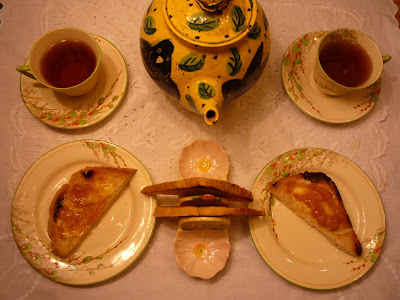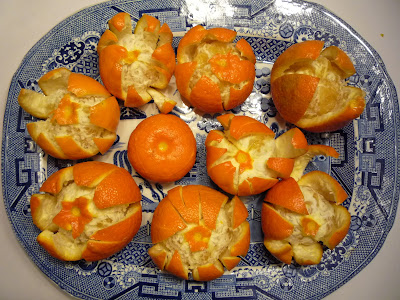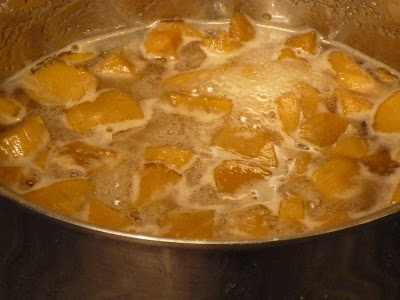This time of year you are probably either snowed under with Summer squash from your own garden or fending off friends and neighbours as they proffer armfuls of their own. We even have one person who flits about the village leaving them on doorsteps or posting them through car windows. It's a shame to undervalue them in a glut because they are nutritious, have anti-oxidant properties and can be eaten in so many different ways. One of our favourites is raw in salads, using both fruit and flowers but below is perhaps a more unusual one, a delicious moist cake.
I first made this some years ago for a village supper and asked everyone to guess what was in it - they could all taste the home-grown ginger but the subtle green colour and hint of some other more elusive ingredient, had them baffled. Since then it's become a regular favourite with so many, so happy to have found another use for the ubiquitous courgette.
The recipe is based upon my favourite Carrot Cake one given to me by my sister and I have used it since to create other cakes with a variety of root vegetables, including beetroot, parsnip and turmeric. In fact I am about to make a marble cake so will post it here in the blog when I have done so.
It's a very simple cake, which really suits organic ingredients which are strong in flavour and need no other additives than their own delicious selves. You could use your own favourite carrot or apple cake recipe to make this too. A word on sugar, I usually halve the sugar requirements as outlined in most old recipes, organic sugar really is sweeter and if you use something like rapadura, has a strong flavour which you do not want to overshadow the rest. As with all cookery, this recipe is about experimentation and you can always add an extra hint of sweetness in the cream Chantilly.
The ginger (foreground above) we grow and make ourselves and there is a link here as to how crystallise it http://simplyorganicrecipes.blogspot.fr/2013/02/how-to-crystallise-organic-ginger-root.html#.U-pbnP5Du5k. A friend has also made this cake with raw grated root ginger and again it's all about experimentation and preferences, particularly in the balance of sweetness. You could make this simple cake with all sorts of seasonal fruits and vegetables, just let your imagination run wild! Just like our courgette plants in the 5 dollar greenhouse below.
Other than the home-grown organics, I get my certified organic ingredients from my local organic shop, which has a charter to source locally whenever possible. My raw cream comes directly from our local organic dairy farm.
Ingredients
8oz (225g) courgettes
A handful of preserved/crystallised ginger
6oz (175g) raw butter
6oz (175g) unrefined caster sugar
2 eggs
8oz (225g) plain flour
5g organic raising agent
(we do not have self-raising flour in France)
A handful of preserved/crystallised ginger
6oz (175g) raw butter
6oz (175g) unrefined caster sugar
2 eggs
8oz (225g) plain flour
5g organic raising agent
(we do not have self-raising flour in France)
Oven Temperature 350 °F (180 °C)
Firstly, grate the courgette and express the juice by pressing through a sieve or just by squeezing it in the hand.
Cream together the butter and sugar, then add the beaten egg. Slowly incorporate the flour and raising agent, then the crystallised ginger and finally the grated courgette.

 Spoon into a buttered and lined loaf tin and bake for one and a quarter hours approximately. To check if cooked insert a cocktail stick into the middle of the cake if it is ready the stick will come out clean.
Spoon into a buttered and lined loaf tin and bake for one and a quarter hours approximately. To check if cooked insert a cocktail stick into the middle of the cake if it is ready the stick will come out clean.The cake can be decorated simply with a dusting of icing sugar but we really enjoy it with raw cream, whipped and slightly sweetened to Chantilly and then decorated with edible flowers and leaves from the garden.
As zucchini plants are so prolific and as the fruits keep well if stored in a cool dry place, you can be eating this cake even as the first frosts begin to bite. A delicious reminder of the changing seasons, brightening up the Winter days with the fragrance and taste of Summer.
..and now if you'd like to, sit back and watch the film:
Thanks for dropping by. All the best and please feel free to comment and share this recipe,
Sue
Return to 'WHAT'S ON THE MENU' for more Simply Organic Recipes
© 2014 Sue Cross



























